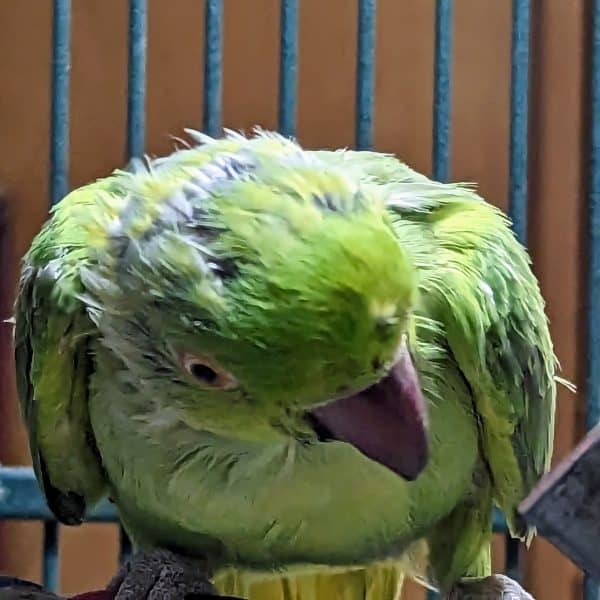Last Updated on by Catherine Tobsing
Matthew Blazo commented
Hello,
I’ve been buying budgie supplies from you guys for over 2 years now and really enjoy your stuff.
I know that you guys have budgies and are extremely experienced with birds.
I am having some trouble with my budgies are you able to offer advice?
I have 2 budgies that are brothers and have only ever lived with each other.
I keep them in the same cage and they are 3 years old now.
The problem I am having is that they will not leave each other alone.
For example, if one is playing with a toy or eating the other one will come over and bug the other one.
Or if either of them is preening the other one will come over and disrupt them.
Also about once or twice a day now they try to mate with each other and I think this makes them frustrated and they fly around the cage.
I’m nervous that they are going to hurt themselves but I am nervous to separate them as they have only ever known to leave with each other.
When I try to separate them it appears they get great anxiety.
Do you have any advice?
Thank you for your time I really appreciate any help you have,
Matthew Blazo
Dear Matthew
Thank you for writing.
I hope we can help with the issue.
We have 10 parakeets in a large aviary, 6 girls and 4 boys and they all get along fine, no pairing off or mating. No eggs laying. All are fully feathered and we see no signs of bickering.
They do chatter every moment of the day and do so until the light goes out.
We attribute our success to them due to one main thing.
We have Full Spectrum bulbs installed in fixtures on timers set 12 hours on and 12 hours off. This particular setting causes them to feel that they are in the summer, all year round.
This helps alleviate hormonal moods that can result in feather picking, mating, egg-laying, aggression, bullying, and so on.
By regulating their hormone levels with the light they are able to be happy, playful little birds and spend their days chattering, eating, playing, flying, etc.
Just as they would in the summer in Australia, all year round.
Your boys may benefit from this sort of lighting set up which will help with aggression for sure.
Also, cage size and the furnishings matter too.
How large is the cage?
Left to right?
If small like 16″-18″, your birds are forced to be with each other every moment and a little bossiness can occur.
As long as they are all eating well, getting enough sleep and no harm is caused, that is good.
But you may wish to get a larger cage, left to right 22″-24″ and up will make a big difference.
This is an excellent choice that takes up little space but offers a good amount of livable space.
Also, they need to have 2-4 or more perches of various thicknesses and materials, even rope. But not just long dowel rod perches.
A single long dowel rod perch in a cage can contribute to aggression as there is nowhere for the less aggressive bird to go to avoid this.
Shorter, single-ended bolt-on perches, 2 in a small cage, and multiples in a larger cage will give lots of landing options and be able to leave open spaces for flying or at least fluttering and hopping around, great exercise.
Then the toys, if you have an aggressive bird and a passive bird they need lots of things to distract them.
Small hanging toys placed so they can be visual blockers help a lot.
Even some fake plastic or silk-type leafy plant branches can help create a hidey spot for the timid bird.
Lattice balls are great fun, thin wood toys, shreddable toys, bells toys all help.
Even a small mirror may help.
It may cause the aggressive bird to fall for a new friend and thus leave the timid bird alone some, or can be a new buddy for the timid bird.
When you get some new things for the cage or even a new larger cage, remove both birds into another cage, carrier, or even a box with a lid.
Then re-arrange the cage fully, move everything around.
Next, put the timid bird in first, followed by the aggressive bird, and close the door.
They will spend their day learning the new arrangement and start developing a new way to live together.
I hope some of this helps, please let me know if I can help you further.
Please let me know if any of this helps with the problem, we love happy stories and pictures.
Matthew Blazo replied
Thank you Catherine!
This has been a tremendous help.
We are going to try the lighting and rearrange the cage and get some new perches and such.
We currently have a 24.8×20.8×32 cage so it is quite roomy for them.
I’ll place an order with you guys today or tomorrow.
Thank you again for all your help!
Author Profile
Latest entries
 The Traveling BirdJune 26, 2025Can You Name 5 Parrot Species That Are Living Wild in the USA?
The Traveling BirdJune 26, 2025Can You Name 5 Parrot Species That Are Living Wild in the USA? Bird BehaviorJune 26, 2025How is it Parrots Are Problem Solvers Social Animals and Even Use Tools?
Bird BehaviorJune 26, 2025How is it Parrots Are Problem Solvers Social Animals and Even Use Tools? Bird & Parrot AnatomyJune 25, 2025How a Tiny Chemical Modification Makes Parrots Nature’s Living Paintings
Bird & Parrot AnatomyJune 25, 2025How a Tiny Chemical Modification Makes Parrots Nature’s Living Paintings PigeonsJune 20, 2025How Do Parrots Thrive in Cities Outside Their Native Habitats?
PigeonsJune 20, 2025How Do Parrots Thrive in Cities Outside Their Native Habitats?




